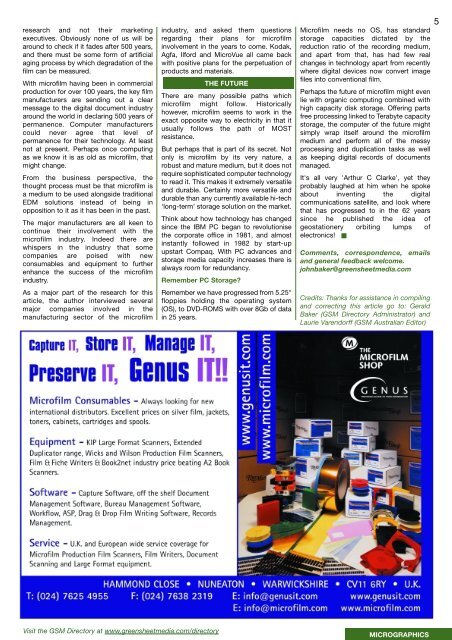Executive Editor, Green Sheet MEDIA
Executive Editor, Green Sheet MEDIA
Executive Editor, Green Sheet MEDIA
You also want an ePaper? Increase the reach of your titles
YUMPU automatically turns print PDFs into web optimized ePapers that Google loves.
esearch and not their marketing<br />
executives. Obviously none of us will be<br />
around to check if it fades after 500 years,<br />
and there must be some form of artificial<br />
aging process by which degradation of the<br />
film can be measured.<br />
With microfilm having been in commercial<br />
production for over 100 years, the key film<br />
manufacturers are sending out a clear<br />
message to the digital document industry<br />
around the world in declaring 500 years of<br />
permanence. Computer manufacturers<br />
could never agree that level of<br />
permanence for their technology. At least<br />
not at present. Perhaps once computing<br />
as we know it is as old as microfilm, that<br />
might change.<br />
From the business perspective, the<br />
thought process must be that microfilm is<br />
a medium to be used alongside traditional<br />
EDM solutions instead of being in<br />
opposition to it as it has been in the past.<br />
The major manufacturers are all keen to<br />
continue their involvement with the<br />
microfilm industry. Indeed there are<br />
whispers in the industry that some<br />
companies are poised with new<br />
consumables and equipment to further<br />
enhance the success of the microfilm<br />
industry.<br />
As a major part of the research for this<br />
article, the author interviewed several<br />
major companies involved in the<br />
manufacturing sector of the microfilm<br />
Visit the GSM Directory at www.greensheetmedia.com/directory<br />
industry, and asked them questions<br />
regarding their plans for microfilm<br />
involvement in the years to come. Kodak,<br />
Agfa, Ilford and MicroVue all came back<br />
with positive plans for the perpetuation of<br />
products and materials.<br />
THE FUTURE<br />
There are many possible paths which<br />
microfilm might follow. Historically<br />
however, microfilm seems to work in the<br />
exact opposite way to electricity in that it<br />
usually follows the path of MOST<br />
resistance.<br />
But perhaps that is part of its secret. Not<br />
only is microfilm by its very nature, a<br />
robust and mature medium, but it does not<br />
require sophisticated computer technology<br />
to read it. This makes it extremely versatile<br />
and durable. Certainly more versatile and<br />
durable than any currently available hi-tech<br />
‘long-term’ storage solution on the market.<br />
Think about how technology has changed<br />
since the IBM PC began to revolutionise<br />
the corporate office in 1981, and almost<br />
instantly followed in 1982 by start-up<br />
upstart Compaq. With PC advances and<br />
storage media capacity increases there is<br />
always room for redundancy.<br />
Remember PC Storage?<br />
Remember we have progressed from 5.25"<br />
floppies holding the operating system<br />
(OS), to DVD-ROMS with over 8Gb of data<br />
in 25 years.<br />
Microfilm needs no OS, has standard<br />
storage capacities dictated by the<br />
reduction ratio of the recording medium,<br />
and apart from that, has had few real<br />
changes in technology apart from recently<br />
where digital devices now convert image<br />
files into conventional film.<br />
Perhaps the future of microfilm might even<br />
lie with organic computing combined with<br />
high capacity disk storage. Offering parts<br />
free processing linked to Terabyte capacity<br />
storage, the computer of the future might<br />
simply wrap itself around the microfilm<br />
medium and perform all of the messy<br />
processing and duplication tasks as well<br />
as keeping digital records of documents<br />
managed.<br />
It's all very 'Arthur C Clarke', yet they<br />
probably laughed at him when he spoke<br />
about inventing the digital<br />
communications satellite, and look where<br />
that has progressed to in the 62 years<br />
since he published the idea of<br />
geostationery orbiting lumps of<br />
electronics! ■<br />
Comments, correspondence, emails<br />
and general feedback welcome.<br />
johnbaker@greensheetmedia.com<br />
Credits: Thanks for assistance in compiling<br />
and correcting this article go to: Gerald<br />
Baker (GSM Directory Administrator) and<br />
Laurie Varendorff (GSM Australian <strong>Editor</strong>)<br />
MICROGRAPHICS<br />
5


